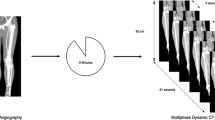Abstract
Purpose
To compare the diagnostic accuracy of contrast-enhanced (CE) three-dimensional (3D) moving-table magnetic resonance (MR) angiography with that of selective digital subtraction angiography (DSA) for routine clinical investigation in patients with peripheral arterial occlusive disease.
Methods
Thirty-eight patients underwent CE 3D moving-table MR angiography of the pelvic and peripheral arteries. A commercially available large-field-of-view adapter and a dedicated peripheral vascular phased-array coil were used. MR angiograms were evaluated for grade of arterial stenosis, diagnostic quality, and presence of artifacts. MR imaging results for each patient were compared with those of selective DSA.
Results
Two hundred and twenty-six arterial segments in 38 patients were evaluated by both selective DSA and MR angiography. No complications related to MR angiography were observed. There was agreement in stenosis classification in 204 (90.3%) segments; MR angiography overgraded 16 (7%) segments and undergraded 6 (2.7%) segments. Compared with selective DSA, MR angiography provided high sensitivity and specificity and excellent interobserver agreement for detection of severe stenosis (97% and 95%, κ = 0.9 ± 0.03) and moderate stenosis (96.5% and 94.3%, κ = 0.9 ± 0.03).
Conclusion
Compared with selective DSA, moving-table MR angiography proved to be an accurate, noninvasive method for evaluation of peripheral arterial occlusive disease and may thus serve as an alternative to DSA in clinical routine.




Similar content being viewed by others
References
Prince MR (1996) Body MR angiography with gadolinium contrast agents. Magn Reson Imaging Clin North Am 4:11–24
Ho KY, Leiner T, de Haan MW, Kessels AGH, Kitslaar PJ, van Engelshoven JM (1998) Peripheral vascular tree stenoses: Evaluation with moving-bed infusion tracking MR angiography. Radiology 206:683–692
Carriero A, Maggialetti A, Pinto D, Salcuni M, Mansour M, Petronelli S, Bonomo L (2002) Contrast-enhanced magnetic resonance angiography MoBI-trak in the study of peripheral vascular disease. Cardiovasc Intervent Radiol 25:42–47
Loewe C, Schoder M, Rand T, Hoffmann U, Sailer J, Kos T, Lammer J, Thurnher S (2002) Peripheral vascular occlusive disease: Evaluation with contrast-enhanced moving-bed MR angiography versus digital subtraction angiography in 106 patients. AJR Am J Roentgenol 179:1013–1021
Winterer JT, Schaefer O, Uhrmeister P, Zimmermann-Paul G, Lehnhardt S, Altehoefer C, Laubenberger J (2002) Contrast enhanced MR angiography in the assessment of relevant stenoses in occlusive disease of the pelvic and lower limb arteries: Diagnostic value of a two-step examination protocol in comparison to conventional DSA. Eur J Radiol 41:153–160
Hentsch A, Aschauer MA, Balzer JO, Brossmann J, Busch HP, Davis K, Douek P, Ebner F (2003) Gadobutrol-enhanced moving-table magnetic resonance angiography in patients with peripheral vascular disease: A prospective, multi-centre blinded comparison with digital subtraction angiography. Eur Radiol 13:2103–2114
Janka R, Fellner F, Fellner C, Requardt M, Reykowski A, Lang W, Bautz W (2000) Dedicated phased-array coil for peripheral MRA. Eur Radiol 10:1745–1749
Goyen M, Ruehm SG, Barkhausen J, Kroger K, Ladd ME, Truemmler KH, Bosk S, Requardt M, Reykowski A, Debatin JF (2001) Improved multi-station peripheral MR angiography with a dedicated vascular coil. J Magn Reson Imaging 13:475–480
Huber A, Scheidler J, Wintersperger B, Baur A, Schmidt M, Requardt M, Holzknecht N, Helmberger T, Billing A, Reiser M (2003) Moving-table MR angiography of the peripheral runoff vessels: Comparison of body coil and dedicated phased array coil systems. AJR Am J Roentgenol 180:1365–1373
Fellner FA, Requardt M, Lang W, Fellner C, Bautz W, Cavallaro A (2003) Peripheral vessels: MR angiography with dedicated phased-array coil with large-field-of-view adapter feasibility study. Radiology 228:284–289
Jacob AL, Stock KW, Proske M, Steinbrich W (1996) Lower extremity angiography: Improved image quality and outflow vessel detection with bilaterally antegrade selective digital subtraction angiography. A blinded prospective intraindividual comparison with aortic flush digital subtraction angiography. Invest Radiol 31:184–193
Smith TP, Cragg AH, Berbaum KS, Ryals TJ, Sato Y (1990) Techniques for lower-limb angiography: A comparative study. Radiology 174:951–955
Gates J, Hartnell GG (2002) Optimized diagnostic angiography in high-risk patients with severe peripheral vascular disease. Radiographics 20:121–133
Cohen J (1968) Weighted kappa: Nominal scale agreement with provision for scaled disagreement or partial credit. Psychol Bull 70:213–230
Meaney JFM, Ridgway JP, Chakraverty S, Robertson I, Kessel D, Radjenovic A, et al (1999) Stepping-table gadolinium-enhanced digital subtraction MR angiography of the aorta: Preliminary experience. Radiology 211:59–67
Reid SK, Pagan-Marin HR, Menzoian JO, Woodsin J, Yucel EK (2001) Contrast-enhanced moving-table MR angiography: Prospective comparison to catheter arteriography for treatment planning in peripheral arterial occlusive disease. J Vasc Interv Radiol 12:45–53
Wang Y, Chen CZ, Chabra SG, Winchester PA, Khilnani NM, Watts R, Bush HL Jr, Craig Kent K, Prince MR (2002) Bolus arterial-venous transit in the lower extremity and venous contamination in bolus chase three-dimensional magnetic resonance angiography. Invest Radiol 37:458–463
Lee JJ, Chang Y, Tirman PJ, Ryum HK, Lee SK, Kim YS, Kang DS (2001) Optimizing of gadolinium-enhanced MR angiography by manipulation of acquisition and scan delay times. Eur Radiol 11:754–766
Owen RS, Carpenter JP, Baum RA, Perloff LJ, Cope C (1992) Magnetic resonance imaging of angiographically occult runoff vessels in peripheral arterial occlusive disease. N Engl J Med 326:1577–1581
Author information
Authors and Affiliations
Corresponding author
Rights and permissions
About this article
Cite this article
Deutschmann, H.A., Schoellnast, H., Portugaller, H.R. et al. Routine Use of Three-Dimensional Contrast-Enhanced Moving-Table MR Angiography in Patients with Peripheral Arterial Occlusive Disease: Comparison with Selective Digital Subtraction Angiography. Cardiovasc Intervent Radiol 29, 762–770 (2006). https://doi.org/10.1007/s00270-004-0309-9
Published:
Issue Date:
DOI: https://doi.org/10.1007/s00270-004-0309-9




